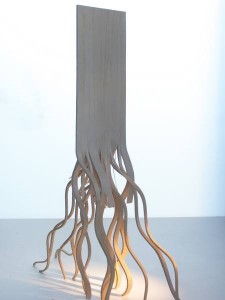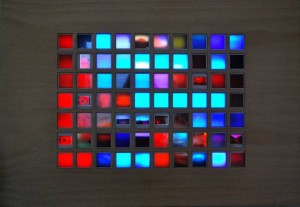Debut guest blogger Meredith Birrell contemplates the things that are there and the things that aren’t there in a recent show by Mark Ryan and Yuri Shimmyo…
Mark O’Ryan’s and Yuri Shimmyo’s recent solo shows at Hardware Gallery left two distinct impressions. Mark O’Ryan presented a unique approach to how we relate to everyday materials by using them in unexpected and delightful ways. Yuri Shimmyo’s oil paintings were far less engaging, distancing rather than inviting the viewer into the contemplative state that she attempted to offer.
Shimmyo dealt with motifs from the everyday – children playing, interiors and domestic objects – all worthy of attention and subjects to which a thinking artist will always bring their own particular slant. The title, Contemplation Theory, asked us to sympathise with the conceptual viewpoint of the artist, but there needed to be room within the works themselves to allow the mind to roam and there was a severity in the paint application itself that denied entry into the work. They were thoughtfully composed and elegant paintings and Shimmyo demonstrated her knowledge of underpainting and colour theory. However, the layering of colour was only barely discernible and much of its effect was lost in the opacity of the final layers. I couldn’t help but wish there had been some softer edges, more mystery and breathing space between areas of paint. With everything so clearly delineated, little is left to the imagination.
In Wind, Rain, Thunder, Storm, four panels forming a panorama of a child battling with his umbrella in a park, there was a missed opportunity to make use of the luminous qualities of oils to make the scallops of the red umbrella glow with captured light, the result instead being flat and heavy. There were some lino prints both framed and unframed in limited editions and these left an even weaker impression than the paintings. In being too conscious of accuracy, Shimmyo lost a freshness and openness in both paintings and prints that would have invited the viewer into her contemplative world.
In the lower part of the gallery, Mark O’Ryan had created a space of sensory illusion where things were not what they seemed. Manufacturing materials such as aluminium, steel, PVC and plywood were used in very surprising ways and while an immediate sense of coherency was elusive, it became apparent that O’Ryan’s exploration into the potential of utilitarian materials was the main conceptual foundation underpinning the show. A soundtrack was provided by Julian Morgan but this is the one element that felt out of place and added nothing to the experience of the work. It felt as if it had been added rather perfunctorily on top of what is already a nuanced and engaging exhibition. Sound added another sensory layer, certainly, but the textures in O’Ryan’s work are so subtle, it distracts from being able to feel their full impact, which emerges piecemeal, like forms in a darkened room as your eyes adjust to low light.
O’Ryan studied industrial design and has worked in set design for TV and film. He brings his impressive skills to bear in the three series of works, Blow Up, 1-7, Landscapes, 1-5, Rig, 1-2 and a single sculptural piece, Oil Lamp. The objects that comprised the Blow Up series appeared to invite the viewer to sit down, until your realised that the pliant looking ‘cushions’ were made of aluminium and the ‘wooden’ bases rusted steel. This surprising discovery made one acutely aware of that habit to immediately categorize we all employ where we make assessments based on minimal information. For the sake of efficiency, we generalise. What looks exactly like a cushion of course must be a cushion. Yet if it is not, if sight can’t be trusted, then we must employ our other senses to know what we are seeing, or rather experiencing. Even the language around art – we go to see a show, we are viewers, we look at a work of art, create a hierarchy where vision is assumed to be the supreme means of knowing. We all have a point of view and a perspective on things, yet O’Ryan asks us to waive the primacy of vision and use our sense of touch instead. The temptation to feel those ‘cushions’ was too great and herein also lay the pleasure of succumbing to an urge, the illicit thrill in touching something you know is off limits, which in a gallery context, works of art generally are. The whole notion of the fragile, untouchable artwork is undone by this emphasis on tactility, by the use of utilitarian materials and by the way the work imposes on the viewer’s physical space. These ‘furniture’ pieces are arranged so that you have to lean over them to view one of the landscape works closely and I don’t think this is an unhappy accident of the limited space. One is forced to negotiate their actual presence in the room and to confront their materiality.
The craft element was evidently important to O’Ryan and there were a variety of confounding techniques and skills that inspired admiration. However it was not all spectacular workmanship, the Landscape series was originally inspired by the Black Saturday bushfires and this context added a poignancy to the tiny landscape photographs that formed part of the work’s grid structure. These images, the size of negatives, were dispersed among squares of lighting gels, lit from behind, so that the whole formed an abstract grid composition of luminous colour. The longer these pieces are contemplated however, the more the acid colour took on an organic sensibility and imbued each landscape with a distinct mood. O’Ryan also plays with scale here as the notion of the landscape in art usually implies the epic; wide panoramas, distant horizons, deep gorges, not the minuscule and certainly not the human. By using such tiny images, our relationship with the landscape and our ultimate dependence on is given emphasis and we sense that each moment we experience is only one cell or fragment in a larger, more complex and ultimately incomprehensible whole.
What united these apparently disparate objects was their material actuality and the way each of them has to be understood through means other than, or in conjunction with, sight. Even the landscape works, although relating more to painting where meaning is grasped through seeing, tap into some other perceptive process that is based on but not solely encompassed by what is implied in ‘looking’. These works have a presence that needed to be felt, rather than purely seen. O’Ryan does investigate some pressing issues such as our use of crude oil and the industrial and chemical waste that is a reality of our world, but the works themselves did not impose an singular meaning. They represented a kind of thinking, not as signifiers to some big issue out there, but as objects that contained their whole function and meaning within their potent presence.



Hi Meredith Birell,
Ripping images from our website and then claiming they are “Curtesy Hardware Gallery” for the purpose of writing an honest, but poorly written review is a sheepish thing to do. Adding “Curtesy Hardware Gallery.” under these images creates the impression that we (Hardware Gallery) did in fact give you permission to use these images and that somehow our curtesy aided you in embelishing a somewhat negative review. We did not give this permission. We think that your review was honest, but lacking in insight, quite negative and sadly contained grammatical errors.
Please do us a big favour and never set foot into our gallery until you understand what “Curtesy” is.
Nice Debut as a guest blogger for artlife!!!!.
FYI:
courtesy [?k??t?s?]
n pl -sies
1. politeness; good manners
2. a courteous gesture or remark
3. favour or consent (esp in the phrase by courtesy of)
4. common consent as opposed to right (esp in the phrase by courtesy) See also courtesy title
5. an archaic spelling of curtsy
Please note Point 3: CONSENT!
Dear Lew, thanks for your comment. We ask that all contributors who supply images make certain that they are granted permission to use them by the gallery concerned. Unfortunately we do not have the time or resources to check that all permissions have been granted and we apologise if this did not happen in this instance. You might want to also run your own comments through a spell check before accusing others of “poor writing” or grammatical “errors”. – Art Life Management
LOL.